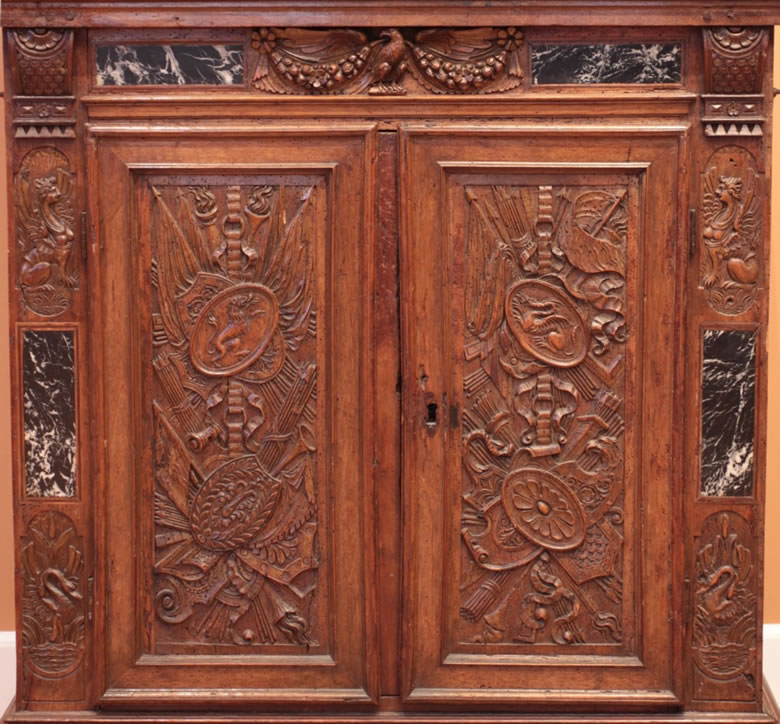Dalva Brothers Antiques, Antique Furniture, New YorkFrench 18th century furniture, clocks, lighting, paintings, porcelain, sculpture and tapestries |
| Louis XIII walnut and marble four door armoire à deux corps with traces of gilding. The small, but highly architectural cabinet, is constructed in two parts, each with two doors. The upper portion has four engaged columns, raised side panels and a broken pediment flanking a raised central plinth. The frieze is centered with a relief of a winged Cupid mask flanked by two inset rectangular panels of black marble with white graining. Each of the two doors is magnificently carved with an assemblage of three military trophies supported by undulating ribbons hung from rings. The trophies are composed of shields, ovals with fantastic animals, flags, quivers, suits of armor, swords and other spoils of war. The compositions, based on antique Roman prototypes, closely resemble those of the Italian, Enea Vico (1523-1598) whose work was copied in France by René Boyvin (1525-1598). They show Roman type military trophies supported by undulating ribbons hung from rings. This type of motif was often used in royal residences in the early years of the Bourbon dynasty to underline the virility and military prowess of the monarch. The larger lower two door cabinet frames its doors with vertical strips headed by a relief of a sejant sphinx, with a rectangular piece of marble in the middle and at the bottom, an oval relief depicting a swan in front of a reed. The upper horizontal portion of the frame is a frieze with a relief of an eagle supporting a swag with his wings flanked by inset rectangles of marble. The brilliantly sculpted doors are carved with reliefs depicting a pair of stacked military trophies similar to the upper doors that are also supported by undulating ribbons hung on rings. The cabinet rests on a large concave molding over two bun feet in front and block feet in back. The interior of the upper section is upholstered, apparently in the original green silk, fastened by ribbon, brass nails and embellished with central brass motifs. [Only traces of gilding remain. One panel cracked. Feet later. Interior silk worn; some internal brass decorations missing. Possible restoration of a few moldings. The statuette at the crest, visible in the de Polés catalogue, is now lacking.] Four other cabinets are known that share many characteristics wih the present armoire and were probably made in the same workshop. Two are in the Louvre, one is in the Philadelphia Museum of Art, and the present whereabouts of the fourth is unknown. They are illustrated on pages 222-223 of the catalogue of the 2002 Louvre exhibition held in the Grand Palais, Un Temps d’Exubérance, les arts décoratifs sous Louis XIII et Anne d’Autriche (“A Time of Exuberance, Decorative Arts under Louis XIII and Anne of Austria”). All have in common the same highly architectural four-door configuration, with seemingly identical bottom concave moldings over front bun feet with block rear legs, four engaged corner columns on the upper portion, insets of seemingly identical marble similarly laid out, a broken pediment with a central element, traces of gilding and at least two have raised side panels. They all have eagle motifs, three with swags supported by wings. The two cabinets in the Louvre and the cabinet whose location is unknown all have swans in the bottom relief of the vertical three-part strip flanking the lower doors. The present cabinet is the only one with military trophies on the doors; the other doors are carved with mythological or allegorical figures. Daniel Alcouffe of the Louvre recently published a 1619 document written by the Paris cabinetmaker Jacques Caignet, describing exactly the lower portion of one of the Louvre cabinets: “…le corps d’embas dudit cabinet est taillé de quatres oyseaux dont deux aigles et deux cignes avec la grand pièce de marbre entre les oyseaux de chacun costé…” (…the lower body of said cabinet is carved with four birds composed of two eagles and two swans with the big piece of marble between the two birds on each side…) This allows a dating of this group as somewhat later than traditionally had been thought. Ex Collection: Madame de Polès: Galerie Georges Petit; June 22-24, 1927. Lot 242 French & Co., New York E. John Magnin, San Francisco (1928) M. H. de Young Museum (1935) Literature: Jacques Thirion: Le Mobilier du Moyen Age et de la Renaissance en France Éditions Faton; Lyon, 1998. The present piece, known from the Mme de Polès collection, is cited on page 173. |
||
| Height (ins.): 74 (188 cm) Length/Width (ins.): 34 (86.5 cm) Depth (ins.): 15.5 (39.4 cm) | ||
| Origin: France, early 17th century Period: Louis XIII | ||
|
|
||
|
||
| << Previous Page | ||




